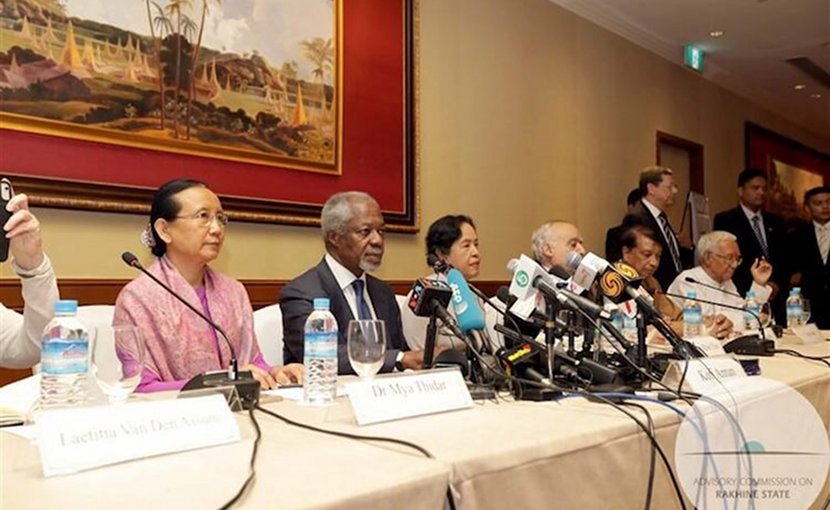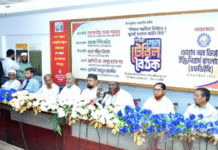
Kofi Annan (second from left) and Aung San Suu Kyi (right of Annan) introducing the report of the Advisory Commission on Rakhine State, Burma (Myanmar).
Burma: Is The Peace Process In Crisis?
By Dr. S. Chandrasekharan
With the international attention on the ongoing Rohingya crisis and Suu Kyi under pressure from all sides, it is but natural that the peace process which is very vital for the country’s stability has taken the back seat. It is said that the third Panglong Conference is unlikely to be held in end November as envisaged.
A leading daily (Frontier) has come out with an article that the peace process is in crisis or at the least facing serious difficulties. It has also suggested that Myanmar will need to find a new way towards peace “if the guns are to be silenced forever.” This statement was provoked by the fact that the expectations have been high particularly from the government side in the hope that with Aung San Suu Kyi in charge of the process peace could be achieved “faster” than might otherwise be possible.
Another article by Joe Kumbun a very knowledgeable Kachin analyst who goes by this pseudonym has described the National Cease fire agreement as a “forlorn hope” and cited the view of one of Dialogue Joint Committee (UPDJC) member Sai Kyaw Nyunt who complained that the cease fire agreement has become “even more complex” and convoluted in the two years since the eight groups that had first signed.
In the same article the writer has commented that the success of the NCA is dependent on four groups- the Myanmar Army, the civilian government, NCA-signatory ethnic armed groups and non NCA-signatory armed groups.
There are a few issues involved in this analysis:
Second, while the four groups are the primary actors, the external factor of China’s involvement and support to the insurgent groups is not being mentioned though it is known to everyone. Two individuals- China’s Special Envoy Sun Guoxiang and the Chinese Ambassador in Yangon Hong Liang have been very active from the beginning. It may be recalled that it was only due to personal intervention of Sun Guoxiang with the Army that the representatives of the Northern Alliance now expanded to “Federal Political Negotiation and Consultative Committee (FPNCC) waiting in Yunan could attend the second Panglong Conference (now named 21st Century Panglong Peace Conference) as observers. The duos are fully in the picture as they appear to be briefed and debriefed by groups close to them regularly on the meetings.
One example of the influence of the Chinese can be gauged by the fact that the Wa group which is the largest (30000?) and best-armed group is supported by China and is in possession of an area that is “no go to the Myanmar Army.” One could argue that in a conventional mode of conflict, a force of 30,000 is nothing against a three hundred thousand regular army of Myanmar – but can Tatmadaw take on a group that is close to the Chinese border and supported by China?
Third, the very fact that the administration led by Suu Kyi was able to get all the disparate groups into one conference is by itself a success. In the second conference, agreement was reached on 37 points-12 of which related to politics which is another positive outcome.
Credit should also go to the administration for managing to talk to most of the groups individually despite the insistence of some groups that they would like to talk jointly!
The point one would like to make is that Myanmar has been experiencing ethnic conflicts from its very inception and both sides carry a lot of baggage which cannot be given up in a few months. The peace process will necessarily be a slow one. One should not forget that the civil administration is not fully in control- One example would suffice to stress on this point.
In the third week of July Suu Kyi had talks with the KBC (Kachin Baptist Convention) and to one question Suu Kyi was asked as to what barriers were in peace process- the reply was that the assaults of Tatmadaw were the main barrier. They urged her government to handle this seriously. She replied- 1. The government was still trying to amend the 2008 constitution and 2. They had only formal relations with the Tatmadaw (the Army) according to the constitution and the government therefore was not in a position to exercise direct control over the Tatmadaw.
In another instance cited by Joe Kumbun, Suu Kyi is said to have admitted the same thing that she cannot control the Tatmadaw under the military drafted 2008 Constitution when she met the New Mon State Party (NMSP) in early September.
The Tatmadaw is in no mood to relent on its hold on the government and its status of being independent of government under the 2008 Constitution.
There is no doubt that the Tatmadaw is the major “linchpin” in the peace process and that Peace or conflict depends on how it responds to the demands of ethnic groups. For example the Army’s (Tatmadaw) insistence that three of the Northern Alliance- the TNLA (Ta’ang National Liberation Army), the AA (Arakan Army) and the MNDAA ( Myanmar National Democratic Alliance Army) should first surrender their arms before they sign the cease fire agreement. In normal circumstances (unless defeated in the field) no armed unit would surrender its arms before a cease fire. Now these groups have joined the alliance formed by the most powerful of the groups- The United Wa State Army.
The result has been that fighting has been going on between these smaller groups and the Army even after the meeting in the second Panglong Conference. In the latest incident, the Arakan Army is said to have ambushed an army boat carrying troops resulting in the deaths of two officers and nine troops. In retaliation the Army is said to have called in helicopter gunships to launch offensives against the group in Rakhine State’s Buthidaung Township.
The AA is now part of the FPNCC led by the Chinese speaking United Wa State Army which in turn looks for support and sustenance from Ruili of Yunan! Similar is the fate of the second largest insurgent unit- the KIO/KIA which is also now part of the FPNCC.
Intermittent fighting continues in the Kachin area too and KIA has been pushed to seek the support of the Wa group. A seventeen-year cease fire agreement with the Kachins fell apart on June 9, 2011 when the Burmese Army attacked a KIA post.
The instances mentioned are not to criticise the Burmese Army (Tatmadaw) but to emphasise how crucial the support of the Army is needed to continue the peace process.
The success of the peace process would also depend upon the eight groups who were signatories to the cease-fire agreement and they seem to be frustrated. After signing the agreement they expected the cease fire process to proceed fast so that they could focus more on development projects besides continuing with the political dialogue to a positive conclusion. In a recent meeting held in the third week of November, the members pointed out the difficulty they were facing about the military whose stance and position have not changed.
A second group- the UNFC which was expected to sign the cease fire agreement soon, is now facing serious differences with the Army on the eight point (nine?) demand they had put forth. The demands relate to cease fire monitoring, code of conduct for the military, troop relocation etc. The group has differences with the government even on the nomenclature of the country to be named as “Federal democratic Union” where as it is reported that the government wants it to be “Democracy and Federal Union.” The UNFC which was once powerful and important enough with 11 members in 2011 is now reduced to just four members – the New Mon State Party, the Karenni National Progressive Party, the Lahu democratic union and the Arakan National Council. They are all light weight groups who do not appear to realise that their demands and the clout they expect to have are not reflective of their strength. It is expected that sooner or later they would sign the cease fire.
The third group-the Federal Political Negotiation and Consultative Committee headed by the UWSA- the United Wa State Army whose members also include another powerful ethnic group- the Kachins. In terms of numbers, the FPNCC would account for 80 percent of the ethnic groups fighting the government. The UWSA first declined to sign the cease fire agreement on the ground that they already had a separate cease fire agreement with the government. Later it changed its stand and is now demanding political autonomy for its Wa self-administered region. As one analyst has pointed out (Sithu Aung Myint of Frontier) – this would tantamount to establishing a separate state for the Wa territory that will never be acceptable to the Army and the government.
The UWSA in having established an alliance with other more important groups has now questioned the fundamentals of the cease fire process on which the two Panglong conferences were held. It is now demanding a separate narrative for the process – first to deal with them as a group and second – stop all offensives and have a political dialogue with them together. The government that spent over two years to bring the peace process forward is not inclined to accept both the demands. This is also one group that has openly called for involvement of China in the peace process.
On the second anniversary of the peace process, State Councillor Daw Aung San Suu Kyi observed that “despite criticism of the NCA, there has been noticeable progress.” She said that they (the government) have successfully decreased conflicts in the regions of the ethnic armed organisations of signatories and as a result the socio-economic lives of the people have improved. She added that there are no reasons to retreat but to go forward towards the desired goal.
Conclusion:
Given the constitutional constraints, the long history of the ethnic conflicts, the inflexible stand of the Army in fighting certain groups and calling for all to sign the cease fire agreement, it is but natural to feel that the peace process is going nowhere. Before political dialogue, discussions on security sector reforms, demobilisation etc, the first fundamental requisite is to have an all inclusive, well monitored, verifiable and enforceable cease-fire. Unless this happens and people in the unfortunate ethnic regions realise the dividends of a long cease fire, no agreement would ever be possible. Suu Kyi may not succeed immediately but she has made a positive beginning for ethnic reconciliation that needs to be carried on by all the stake holders without outside interference.









